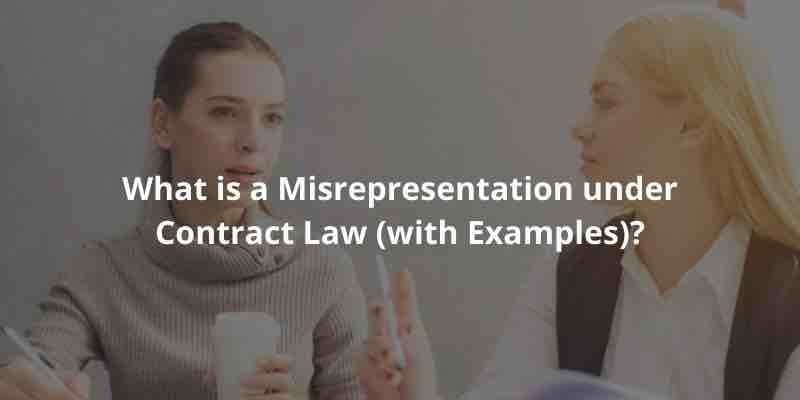What is a Misrepresentation under Contract Law (with Examples)?
7 Dec 2023
15 Jan 2021
min read

Business contracts are often the subject of protracted negotiations in which much is said by both parties to lure the other to enter into a contract on particular terms. These representations may or may not be included in the contract.
One of the biggest risks to your business when engaging in such negotiations is misrepresentations. These misrepresentations may be damaging to your business and whether there are remedies if the contract has been concluded based on these misrepresentations.
This guide provides an overview of misrepresentations in contract law including the common protection mechanisms any business should use to limit their liability should they, unfortunately, make a misrepresentation.

What is a misrepresentation?
A misrepresentation is a false statement of law or fact made by one party (party A) to another party (party B) which induces that other party (party B) to enter into a contract.
Such statements of law or fact constituting a misrepresentation are normally in written words. Such statements can also be made by other modes of communication – such as verbally, through gestures, or conduct.
A statement constituting a misrepresentation may be found in sales literature, a company website, or an advertisement.
Legal elements in misrepresentation:
There are two elements, generally, which must be found to be present for a misrepresentation:
1) There must be a false statement of fact or law made to a party intending to enter into a contract, which
2) Induces that the other party to enter into a contract

Which statements can constitute a misrepresentation?
The first legal element which must be present for misrepresentation is a false statement of fact or law made to a party intending to enter into a contract.
Depending on the type of statement you have made, it may or may not be able to constitute a misrepresentation.
1) Statements of fact
Statements of fact, whether concerning past or present events, will constitute representations.
2) Statements of opinion
A statement of opinion, if false, as a general rule, does not constitute a misrepresentation.
This is unless the statement is interpreted to be a statement of fact. If it is a statement of fact, and it can be proved that the person who gave it, did not hold it then this will constitute a misrepresentation.
Whether a statement is a statement of opinion or fact is to be interpreted by the courts in light of the circumstances in which the statement was made.
3) Statements of future intention:
Statements that indicate the future intentions of a party often amount to statements of fact. This is because such statements of future intention often imply that a particular state of affairs exists at present.
4) Silence
Silence by a party, generally will not constitute a misrepresentation. This is because pre-contractual negotiations, in most common law jurisdictions, are thought to be an adversarial affair. Neither party, as part of such pre-contractual negotiations, thereby, have a responsibility to disclose anything to the other party which may influence their decision to enter into a contract.
This rule is not absolute, however. There are exceptions to it, including:
A) Half-truths
A half-truth is where a party makes a statement of fact or law that is on the face of it true, but, because of certain things left unsaid, the representation is false, and thereby constitutes a misrepresentation.
B) Certain contracts of utmost good faith (uberrimae fidei) and contracts involving fiduciary relationships
Certain contracts such as contracts Uberrimae Fidei (contracts of the utmost good faith) require a party to disclose all material facts to the other that may influence their decision to enter into a contract.
Contracts of uberrimae fidei are often characterised by one party having nearly all information relevant to a contract, whereas the other has nearly none. A common example of such contracts of utmost good faith is insurance contracts.
Certain other contracts involving fiduciary relationships, similarly require one party to disclose all material facts to the other.
C) Misrepresentation by conduct
Misrepresentations by conduct by virtue do not involve any communication by words, whether written or spoken. Misrepresentations by conduct, by definition, thereby, can be made in silence.
Whether conduct amounts to a misrepresentation, is to be interpreted by the courts in light of the circumstances in which the statement was made.
D) Change in circumstances
A misrepresentation can be found, despite a party being silent, because of a change in circumstances.
This happens when a party makes a statement of fact or law to another party, which when made is true. However, there is a change of circumstances before the other party enters into the contract, which renders the representation false. The statement of fact or law – the representation – is now a misrepresentation.
For the party making the representation to avoid making a misrepresentation, the party making the representation has a positive duty to notify the other of the change in circumstances. In other words, the party making the representation should notify the other party about the change in circumstances and the fact that the representation is no longer true.

What is inducement?
The second legal element which must be present for misrepresentation is the statement made to induce another party to enter into a contract.
For there to be an inducement, four additional elements must be present. We will go through each one in turn.
Firstly, for inducement, the party to whom the misrepresentation is made, must be materially influenced to enter into the contract by it (except in the case of fraudulent misrepresentations).
This requirement for inducement means, that if the party to whom the misrepresentation is made knows about the misrepresentation and thereby does not rely on it, there is no inducement.
The misrepresentation need not be the sole reason or influence for the party entering the contract, however. It is not enough for the party to merely show they were encouraged to enter into the contract by the misrepresentation. It must materially influence the party – or in other words, have a strong influence on the party’s decision to enter into the contract.
Secondly, for inducement, the claimant must actually know about the misrepresentation. If a claimant does have knowledge about the misrepresentation, there is no way they could be influenced by it and thereby no way they could be induced by it.
Thirdly, it must be shown that the party making the misrepresentation intended to induce the other party into a contract.
Finally, it must be shown that the claimant actually relied upon the statement and actually, in fact, entered into the agreement.
What types of misrepresentation are there?
There are three types of misrepresentation: fraudulent misrepresentation, negligent misrepresentation, and innocent misrepresentation.
They each have different requirements, and different corresponding remedies if found to be present. We will cover each one in turn.
1) Fraudulent Misrepresentation
A fraudulent misrepresentation is made where a false statement of fact or law is made by a party to another:
-
Knowingly;
-
Without belief in its truth; or
-
Recklessly as to its truth
The party making the representation should be shown to make a statement knowing it is false or without belief in its truth. In other words, it must be proven that the party making the representation did not honestly believe that the statement was true.
If the party making the statement does honestly believe the statement made to be true, there is no fraud.
A fraudulent misrepresentation will also be found if it can be proven that a false statement was made recklessly by a party. A false statement is made recklessly if it is made by a party without caring whether the statement is true or not.
If a party is merely negligent in making a false statement – in other words, makes a statement without care – there is no fraudulent misrepresentation. It may, however, constitute a negligent misrepresentation (see below).
2) Negligent Misrepresentation
This is a false statement made by a person to another without any reasonable grounds for believing it true.
In England & Wales, negligent misrepresentations are governed by s.2(1) of the Misrepresentation Act 1967.
Under s.2(1) of the Misrepresentation Act 1967, the injured party must first prove that a statement was made to him which was false and induced him/her to enter into a contract. The party making the statement must then prove that they had reasonable grounds for believing the statement to be true.
3) Innocent Misrepresentation
Innocent misrepresentation is where a statement of fact or law is made by a party, honestly believing it to be true.
For an innocent misrepresentation, there is no fraudulence or negligence by the party making the statement. In other words, there is no dishonesty or carelessness when making the statement.

Why are misrepresentations risky to your business?
The possibility of making a misrepresentation is risky, firstly because you can be sued. Not only is being sued bad for your business’ reputation but it could also be for its bottom line.
It can be bad for its bottom line because of the harsh remedies you might be subject to if successfully sued by another party.
There are generally two remedies available for misrepresentations: recission of contract and/or damages.
Rescission is where a contract is set aside, and the parties are put back into the position in which they were before the contract was made. Damages are a monetary award to compensate the injured party for some loss or injury – in this case, misrepresentation.
As stated above, the different types of misrepresentation are significant because the remedies available for each differ.
This is because, whether only one or both of the remedies are available – rescission and damages - in a particular case depends upon whether the misrepresentation at issue is fraudulent, negligent, or innocent.
The following table should clearly show the remedies available for each type of misrepresentation:
|
Type of Misrepresentation |
Remedies Available |
|
Fraudulent Misrepresentation |
Damages and rescission |
|
Negligent Misrepresentation |
Damages and rescission |
|
Innocent Misrepresentation |
Rescission |
It is important to note that in the case of negligent misrepresentations and innocent misrepresentations, the court can offer damages in the place of rescission. This is not the case for innocent misrepresentations, however.
The damages for misrepresentation are particularly harsh because they are calculated based on the law of tort not the law of contract. This is important for your purposes because the damages in the law of tort have scope to be considerably higher.
This is because damages in the law of tort are calculated differently and a lot of rules that would otherwise apply in the case of damages for contract do not apply in the case of tort, leading to higher damages.
The possibility of making a misrepresentation is risky, secondly, because it can jeopardise other contracts your business might have entered into.
If your business is found to have made a misrepresentation, this can have knock-on effects on many other different agreements to your business is a party.
This is especially so in the case of loans. It is common for loan agreements to include a clause stating that any finding of misrepresentation will constitute an event of default.
This event of default might lead to the loan being accelerated – in other words, you might be liable to pay the loan immediately, well ahead of the originally intended schedule of payments.
In the worst case, it might even lead to cross-accelerations – in other words, multiple loans might become wholly due for payment immediately. This can quickly lead to cash-flow problems for your business, and in the worst case, bankruptcy.
What should one do if another party makes misrepresentation them?
After long negotiations with another party, your company agrees to buy an expensive piece of machinery from them. You receive the machine and find out that it doesn't have many of the functions it was held out to have. You realise, the other party has misrepresented the machine to you! What do you do now?
You should start by, firstly, writing a letter of complaint to the other party requesting a full refund and explaining that they have made a misrepresentation. This complaint will hopefully lead to negotiations with the other party for some sort of settlement. Coming to a mutually agreeable settlement in this way is often the best and cheapest form of resolution for a misrepresentation.
DocPro offers comprehensive template letters for misrepresentation which you can use. You can find it at the following web address: https://docpro.com/doc1125/complaint-letter-for-misrepresentation-product-service
If both parties are unable to come to a settlement by negotiation, you may have to pursue more formal legal action in the form of litigation. For this, you should consult a lawyer in your jurisdiction.
Limiting liabilities for misrepresentations
Making a misrepresentation can have a detrimental impact on your business. It is pivotal, therefore, that you take care when making statements as part of pre-contractual negotiations for your business.
It is also wise, for you to take steps to limit your liability should a misrepresentation, nonetheless, unfortunately, be made by your business. This can be done by including clauses to this effect in your contracts, including the following:
-
Exclusion clauses
-
Limitation of liability clauses
-
non-reliance clauses
Businesses should make sure that when inserting such clauses into agreements, to make sure it is ‘reasonable’. If they are drafted too broadly, they may be struck down in accordance with unfair contract legislation in the business’ respective jurisdiction.
Keywords:

